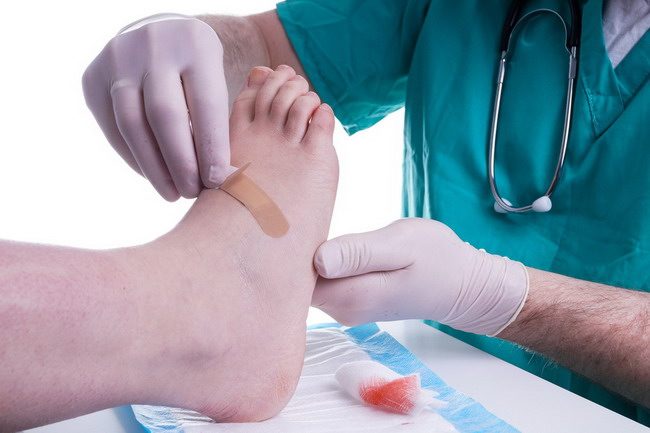Nothing is called Dry Diabetes or Wet Diabetes
Diabetics in Indonesia often categorize the disease into two types, namely dry diabetes and wet diabetes. In the medical world itself, there is actually no such thing as dry or wet diabetes.
In general there are three types of diabetes, namely type 1 diabetes, type 2 diabetes, and gestational diabetes during pregnancy. Although the type of diabetes is different, the condition is equally indicative that a person has high sugar levels in the blood.
Nothing is called Dry Diabetes or Wet Diabetes
The Causes of Injuries to Diabetes Are Difficult To Cure
Diabetes often makes sufferers vulnerable to injuries that don't heal, especially in the legs. Indonesians often equate this condition as wet diabetes. Even the smallest wound in diabetics must be treated properly. Because, diabetic wounds that are not immediately resolved can turn into diabetic ulcers, which often occur in the feet of diabetics. In some cases, severe ulcers cause diabetic limbs to be amputated.
There are several factors that can cause the wound to be difficult to cure, namely:
Poor blood circulation
High levels of sugar in the blood can cause various complications. One of them is narrowing of the arteries or peripheral arterial disease. This condition makes blood flow from the heart to all parts of the body become obstructed, so that the supply of oxygen and nutrients is difficult to channel throughout the body. In fact, the injured body parts desperately need oxygen and nutrients contained in the blood to speed up the healing process.
Decreased immune system
Increased levels of sugar in the blood causes the cells responsible for keeping the immune system weak. Therefore, even a small wound can cause severe infection.When this is the case, immune cells cannot heal or dry wounds quickly in diabetics.
Nerve damage
One factor in the difficulty of healing or drying wounds in diabetics is neuropathy (nerve damage). Neuropathy itself is a condition in which the body cannot feel something or is numb. This is because the nerves in the body have been damaged due to high blood sugar levels that cause nerve tissue not to get enough blood flow. Usually this condition is more common in the legs and arms. Because it doesn't feel any pain in the injured area, you may not realize if the wound is frictionless, gets worse, or has a new wound.
Handling Wounds for Diabetics
Unlike normal people, diabetics need to be careful if their limbs are injured, especially in the legs, because even the slightest wound if not handled properly can endanger the overall body condition.
The following are first-aid wound treatments in diabetics:
Clean the wound area from dirt using soap and running water, regularly. After the wound is clean, apply an antibiotic ointment to the injured part of the foot. Then cover the wound with a sterile bandage.
Avoid using antiseptic drugs, wound cleaning fluids containing alcohol, or products made from iodine. These products actually cause irritation to your skin.
Avoid using narrow shoes that make your legs depressed. Excessive pressure on the wound area allows the wound to get worse.
Maintain blood flow to keep it smooth, by increasing your legs and keeping your feet straight so that the blood flow is not getting more disturbed.
Always pay attention to signs of infection that appear on the wound. Symptoms of the appearance of an infection can be pain, redness, pus, the location of the wound feels hot and swollen, and fever.
Keep in mind, if the wound in the leg does not heal after receiving self-care, it is recommended to immediately see a doctor, so that the wound does not worsen and becomes difficult to handle.
Preventing Wounds in Diabetics
Given the risk of injury to diabetics is too high, it is better to take precautions before the injury occurs. The following are things that can be done as prevention:
Routinely cleanse your feet using warm water. After that, dry all the limbs, especially between the toes. Use a lotion to keep the skin moist.
Gently rub the surface of the foot with pumice or a special tool to smooth the surface of the foot. This can also be done as a prevention against the appearance of calluses and fish eyes on the feet.
Always use footwear when you are outside the home or inside the house. This aims to avoid injury to the legs. Avoid using socks that are too tight because it can reduce blood flow.
Avoid wearing shoes that are uncomfortable, such as high heels. Instead, choose shoes that have heel pads and are larger than your feet.
Cut your nails carefully. This is intended to avoid foot injuries due to nail clippers. Ask for help from others, if you are not able to cut your nails yourself.
Check the condition of the feet every day, make sure the condition of the feet is normal and there are no signs of injury and infection.
In addition to doing wound prevention as described above. You also need to manage diabetes by eating healthy foods, not smoking, and exercising regularly.
Also remember, the term dry diabetes or wet diabetes is actually not in medical terms.Whatever type of diabetes, you should still see a doctor to get a complete health check and the right treatment. If there are diabetic wounds and it is difficult to treat them at home, you can go to the nearest hospital or health facility to do wound care.
source:
https://www.alodokter.com/tidak-ada-yang-namanya-diabetes-kering-atau-diabetes-basah


0 Response to "Nothing is called Dry Diabetes or Wet Diabetes"
Post a Comment